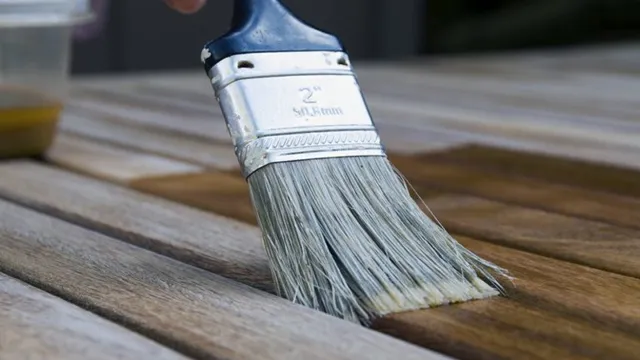Staining wooden surfaces can bring out their natural beauty and make them look new again. However, the process can be somewhat challenging, especially if you’re working in cold conditions. Staining in such temperatures may lead to poor results, discoloration, and even damage to the wood.
But does this mean that you cannot stain wood in cold conditions? The answer is no; staining wood in cold conditions is possible. All you need is the right information and tools to get the job done right. In this blog, we’ll explore tips and tricks for staining wood in cold conditions and how to achieve the best results.
So, let’s dive in and learn some exciting wood staining techniques!
Understanding Stain Application
If you’re wondering whether you can stain wood in the cold, the answer is it depends. While you may be able to apply the stain, it may not dry properly in colder temperatures. Ideally, the perfect temperature for staining wood is between 50- and 80-degrees Fahrenheit.
If the temperature falls below 50 degrees, the stain may not dry as quickly, which can result in inconsistencies and wood that won’t absorb the stain properly. It’s also important to consider the humidity levels when staining wood; high humidity can cause the stain to take longer to dry, leading to uneven results. So, while it’s possible to stain wood in colder temperatures, it may be best to wait for warmer, dryer weather to achieve the best possible results.
Temperature Considerations
When it comes to staining wood, temperature is a critical factor that people often overlook. Applying stain during extreme weather conditions can lead to undesirable results, as the wood may absorb the stain unevenly or fail to absorb it at all. Ideally, you should apply stain when the temperature is between 50°F and 90°F, and the humidity is relatively low.
This range ensures that the wood can absorb the stain evenly and helps prevent the stain from evaporating before it can penetrate into the wood. If you’re staining indoor surfaces, make sure the room is well-ventilated, so the fumes don’t affect your breathing. Remember, for a perfect finish, always follow the manufacturer’s instructions and recommendations.
By paying attention to the temperature requirements, you can ensure that your wood staining projects turn out great.

Drying Time and Curing
When it comes to staining wood, understanding the drying time and curing process is crucial. Drying time refers to the time it takes for the stain to dry on the surface of the wood, while curing time refers to the time it takes for the stain to fully bond with the wood. It’s important to note that these times can vary depending on various factors such as temperature, humidity, and the type of stain used.
Typically, oil-based stains take longer to dry and cure compared to water-based stains. It’s best to wait until the stain is completely dry before walking on or touching the surface to prevent unwanted smudging or smearing. It’s also important to wait until the stain is fully cured before applying any additional finishes or sealers to ensure proper adhesion and durability.
Overall, following the recommended drying and curing times for your chosen stain will ensure a beautiful and long-lasting finish for your woodworking project.
Preparing Wood for Staining
Staining wood can be a great way to preserve and enhance its natural beauty, but it’s important to properly prepare the surface before applying any stain. While many people may wonder if it’s possible to stain wood in the cold, the truth is that it’s generally not recommended. Cold temperatures can affect the drying and curing of the stain, which can result in uneven color and poor adhesion.
It’s best to wait until the temperature is at least 50-60 degrees Fahrenheit before staining wood, and to ensure that it’s clean, sanded, and free of any debris or previous finishes. This will help the wood absorb the stain evenly and produce a beautiful, long-lasting finish. So while it might be tempting to tackle a staining project in the winter months, it’s worth waiting for warmer weather to ensure the best possible results.
Conditioning the Wood
Conditioning the wood is an important step in preparing it for staining. This involves removing any existing finish or paint, sanding the surface, and applying a wood conditioner. Wood conditioner is used to even out the stain absorption and prevent blotchiness.
It’s necessary to apply the conditioner before staining if the wood has a porous surface. This will ensure that the stain penetrates evenly into the wood grain, producing a uniform finish. Prior to conditioning, make sure to clean your wood thoroughly to remove any dirt or dust particles, as this can affect the absorption of the conditioner and stain.
By taking the time to properly condition your wood, you’ll be able to achieve a professional-looking finish that will last for years to come.
Proper Surface Preparation
Proper surface preparation is crucial when it comes to staining wood. Before staining, the wood surface must be clean, dry, and free of any dirt, dust, or debris. Any imperfections, such as scratches or dents, must be repaired or sanded down.
It’s important to note that different types of wood may require different preparation methods. For example, hardwoods like oak or maple may need to be sanded with a fine-grit sandpaper to achieve a smooth surface, while softwoods, such as pine or cedar, may require a wood conditioner to prevent blotching. Regardless of the type of wood, it’s important to follow the manufacturer’s instructions and take your time with the preparation process to get the best possible results.
Remember, the success of your staining project largely depends on how well you prepare the surface beforehand. So, don’t rush this important step if you want your stained wood to look its best.
Choosing the Right Stain
When it comes to staining wood, the preparation process is just as important as choosing the right stain. Before applying any stain, it’s crucial to properly clean the surface of the wood, removing any dirt or debris that could affect the finish. Sanding the wood is also essential to ensure a smooth, even surface for the stain to adhere to.
It’s important to use the correct type of sandpaper for the job, starting with a coarse grit and gradually working your way to a finer grit. This will help to smooth out any imperfections in the wood grain and ensure that the stain goes on evenly. Once the wood has been cleaned and sanded, it’s important to apply a pre-stain conditioner to help the wood absorb the stain evenly and prevent blotching.
By taking the time to properly prepare the wood for staining, you’ll be able to achieve a beautiful, long-lasting finish that will enhance the natural beauty of the wood.
Tips for Staining Wood in the Cold
Can you stain wood in the cold? The answer is yes, but it requires some special attention to ensure the best results. First, it’s important to check the temperature requirements of the stain you plan to use and make sure it’s suitable for cold temperatures. If the temperature is too low, the stain may not dry properly or could cause other issues.
Additionally, you’ll want to make sure the wood is dry and free of any moisture before staining to prevent any unwanted reactions or uneven results. To achieve the best results, it’s also recommended to warm up the wood before staining by bringing it inside or using a heat source. Otherwise, the cold wood could resist the stain or absorb it unevenly.
These tips can help you successfully stain wood in the cold while avoiding any potential issues.
Working Indoors
Staining wood during the cold winter months can be a tricky task, especially when working indoors. However, there are a few tips and tricks that can make the process much more manageable. One important thing to keep in mind is that the cold temperature can affect the consistency of the stain, causing it to thicken and making it harder to work with.
It’s essential to warm up the stain before using it by placing the can in a warm area or running warm water over it. Additionally, it’s vital to ensure proper ventilation to prevent fumes from accumulating in the room. This can be accomplished by opening windows or using a fan.
Lastly, it’s crucial to choose the right type of brush for the job. A natural-bristle brush will work best, helping to create a smooth and even finish. By incorporating these tips, you’ll be able to stain your woodwork with confidence, no matter the temperature outside.
Using a Space Heater
When it comes to staining wood in colder temperatures, it’s important to take certain measures to ensure the best outcome. For starters, consider using a space heater to warm up the area where you’ll be working. This will not only make it more comfortable for you, but it will also help the stain dry more evenly.
Additionally, be sure to stir the stain thoroughly before applying it to the wood. Cold temperatures can cause the stain to separate or thicken, so it’s important to mix it well to achieve a consistent texture. Another great tip is to work in smaller sections, as the colder temperatures can cause the stain to dry faster than usual.
By working in smaller areas, you can ensure that you’re able to apply the stain evenly and smoothly before it dries. So, don’t let the cold weather put a damper on your wood staining project- just follow these helpful tips and you’ll be able to achieve beautiful, professional-looking results!
Conclusion and Final Thoughts
While it may be tempting to try to stain wood in the cold, it’s important to remember that temperature can have a major impact on the quality of your results. Just like how chilly weather can make you shiver and shake, the cold can cause your stain to dry unevenly, leaving you with a less-than-perfect finish. So if you want to ensure that your wood comes out looking beautifully stained, it may be best to wait for warmer weather or find an indoor work space with controlled temperature.
After all, a little patience and preparation can go a long way when it comes to DIY projects!”
FAQs
Can I stain wood in cold temperatures?
Yes, you can stain wood in cold temperatures, but it may take longer to dry and cure than in warmer temperatures.
What is the ideal temperature for staining wood?
The ideal temperature for staining wood is between 50-80°F (10-27°C).
What are the risks of staining wood in cold temperatures?
Staining wood in cold temperatures can lead to uneven drying and curing, as well as slower drying times.
Can I use a different type of stain in cold temperatures?
Yes, you can use a different type of stain in cold temperatures, such as water-based stains, which tend to dry faster than oil-based stains.
How long should I wait to apply a second coat of stain in cold temperatures?
It is recommended to wait at least 24 hours before applying a second coat of stain in cold temperatures.
What precautions should I take when staining wood in cold temperatures?
It is important to protect the wood from freezing temperatures and moisture, as well as ensuring proper ventilation in the area to allow for proper drying.
Can I speed up the drying process of stain in cold temperatures?
Yes, you can speed up the drying process of stain in cold temperatures by using a fan or heater (set on low) to provide extra warmth and air movement.






